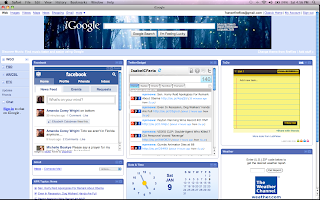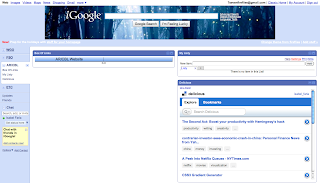Monday, January 25, 2010
BP12_2010013_MinuteMessage#2
BP11_2010013_Commentlink_Amanda
Sunday, January 24, 2010
BP9_2010013_Web2.0 T3-FreshBrain

I am really impressed with the magnitude of this Web 2.0 tool called Fresh Brain (www.freshbrain.org). Fresh Brain is a community, a social networking site, a creative studio where teens can virtually explore, create, learn and share projects in the areas of development, ecology, gaming, graphic design, music, venture, videos and web. Fresh Brain was created with the goal of complementing the school curriculum. It brings to students the technological learning opportunities that teachers are unable to provide in the classroom due to the lack of time or training. After navigating the site one can see that it is a combination of different small environments contained in a bigger one.
As a community, it is similar to social sites like Facebook and Myspace that allows students to share ideas and connect; this community also includes parents, teachers and the support of a volunteer staff. But more than just a forum, they took it a step further and made it a platform where technology meets creativity.
As a learning environment, students have the support of tools, tutorials, and classes. They receive advice from a community of volunteers and they can work individualy or in teams. These activities are then posted on the site for sharing.
As a studio, it is a place where projects are created following a plan from conception to completion. Teachers can take advantage of this tool in the classroom by assigning projects that will enhance student’s knowledge. It provides the students with a real world scenario where a project can be completed in a number of weeks by one student or in several months by a team.
It has the support of Sun Microsystems, T Mobile and other corporations that among other benefits, provide the access to technology and volunteers. In addition to the benefits or learning, and sharing there are opportunities for scholarships.
This tool provides a place where teen students can create and thrive.
Monday, January 18, 2010
BP8_2010012_1MinuteMessage
This Academic project is for nonprofit educational purposes
Music: "Carousel" retrieved from the Garage Band native database.
Images were electronically randomly selected from Flickr.com
BP5_2010012_Web2.0 T2_TagGalaxy
I would like to suggest visiting some very cool planets that gravitates in a virtual galaxy not so far away. It is called Tag Galaxy. It is lots of fun and very simple to use. Tag Galaxy is an image search application that works with Flickr and it is created using papervision3D (PV3D), those a little more tech curious can find more about papervision3D here.
The application starts to work when an initial tag word is entered in the text field provided, it could be a word like flower or a concept like happy. At that point, planets will start to animate and appear on the screen carrying other related tag words. A collection of tag words can be chosen by selecting the planets. Click on the window hold and drag and the planets will rotate around. Click on the main planet in the center of the universe to see all photos related to your collection populate like a beautiful mosaic of colorful images. The tag words are collected on the bottom left hand corner of the screen. A full screen mode is also provided.
There are unlimited uses for this tool in the classroom, on a Smart Board projector use it with the kindergarten class to show them simple images like flower, summer, and winter. Show older students what it means to be from a certain culture. Of course, like with many internet tools, teachers need to be careful by pre-selecting words that would bring only safe images and for the older student, to address appropriateness of content. Other than that, this tool is visually rich and interactive, truly an eye candy. Of course this same search can be done by using Fliker but doing troughTag Galaxy is a whole lot much more fun!


Monday, January 11, 2010
BP4_2010011_RSS Feeds

Edutopia – http://www.edutopia.org/
This was the first site I added to my Google reader and one of the first sites I explored as I started the EMDT program. A must for everyone involved in education, may they be in the administration role, teacher role, parent or even student. I found it to have a great interface that caters to the newbie as well as the seasoned educator. I am certain I can benefit from the knowledge that I acquire from its documentaries, interviews, links to other relevant sites and research, among other resources. Edutopia is the platform that The George Lucas Educational Foundation (GLEF) empowers us in education to aim for better and more state of the art future for all students. I also started subscribing to their site on Twitter.
TED - http://www.ted.com/
A place created where, technology, design and entertainment are joined and endorsed by conferences given by the doers and thinkers of the world. I am absolutely enthralled every time I listen to one of the conferences from their site, I can listen from my computer at home. These conferences given by experts can support many of the subjects taught in school. A new feature of the site is the opportunity to subscribe to their conferences in real time. What a great site to learn from, talk about and hope for a faster future.
T.H.E. Journal - http://thejournal.com/Home.aspx
I stumbled upon this site on my own surfing the Internet and found it to be a great resource for education. This is a site that covers articles and news and trends in education technology, right up the EMDT student’s alley. This site gives me the variety on the type of news that I receive so I can always be up to date for my students. I also think that its longevity (created in 1972) and high circulation, gives me reliability I look for. I can certainly benefit from its product reviews and peer-written articles.
Associated Press - http://www.ap.org/
The Drudge Report - http://www.drudgereport.com/
Who can live without the news? My other two options for my Google reader, and that can never be missing from anyone’s collection either, are two sites that provide news and current information. From the Associated Press website I can read the news and stories contributed from different and many sources such as radio, television and newspapers. It is considered one of the most reliable and complete sources of news and points of view in the United States. I also chose the Drudge Report website because it provides me with an aggregation of news in one unique website. With a more conservative point of view, I enjoy its daring journalism as some of their stories are written from tips that their journalists receive. They were the first to break the news of Monica Lewinsky scandal after another paper decided not to publish the story. In my view, this makes them a proactive and most updated source of news. This will certainly give a well rounded prospective of the world to share with my students.
BP3_2010011_Web2.0 T1-WIX
Wix is a free Flash based website builder tool that uses drag-and-drop functions. There are many advantages of using Wix, besides the fact that it is absolutely free to create a basic site, and a basic site includes many design features and functions. No programming knowledge is needed, just a little creativity, and even for those not so creative types, there are plenty of templates to choose from. The result is a professional looking site that can be used for many purposes including e-commerce.
As Career Advisor for graphic design students who might not have previous knowledge of web design, this site is the perfect tool for me to recommend as a portfolio site. Every graphic design student know that in order to be competitive in the job market one needs to have an online portfolio of their work. This is a must for any employer to consider them a feasible candidate. With the restricted budget that a new graduate usually experiences using Wix sure beats paying for the service of an expensive web designer/developer that could cost US$200 plus for just a simple site. I need to mention that there is an option for a premium paid account, but even this option I considered reasonable. Starting at less than US$5.00 per month, one can use their own domain name, remove sponsor ads, have additional storage space and other extra features.
So I decided to get my feet wet with Wix and create a personal website, starting with the home page to post some of my family recipes that were long forgotten in a drawer somewhere in my house. I was very impressed with the interface and how easy it was to change the elements of the page. Wix even offered a selection of their own clipart, images and other features that includes widgets like RSS feeds, Google maps and PayPal. All that for free.
Here is a picture of the original template that I started from.

Sunday, January 10, 2010
BP2_2010011_EduUses4Blogs

Since its modest days in 1998, “weblogs” or the more popularized named version “blogs” have gown incessantly every minute of the day. According to Technorati Media, a blog search engine, that indexes millions of blogs, about 175,000 new weblogs are created each day, and each second of the day 2 blogs are created making the 1.6 Million postings per day (Dube, 2007).
We liked it when blogs allowed us access to a more personal perspective of the world events, in the case of September 11th or the Afghanistan war when hundreds if not thousands of bloggers flooded the Internet telling stories about their own experiences or sharing opinions. Blogs unite readers as active participants allowing interaction and contemplation of learning. It gives the guarantee of different points of view prompting a more unabridged truth.
The popularity of blogging, the minimal technical knowledge, and the fact that all one needs is a computer an Internet connection to engage in conversation with almost anywhere in the world made inevitable that its benefits would spill into the education realm. Educators fortunately and in time, noticed the benefits blogging brings into the education as they communicate and engage the digital natives to work more collaboratively with each other. Blogging pushes students to discover new ways of thinking. It is the informality of blogs that allows them to reflect and evaluate their opinions in a better light and express it in their own voices.
In addition to providing teachers with an excellent tool for communicating with students, blogs motivates students, even those who would otherwise be too timid to contribute in a regular classroom. Blogging gives excellent opportunities for students to read and write due to the forum environment they provide for collaboration and discussion, they are powerful tools that enable scaffold learning or mentoring (Crie, 2006).
As students sit in their new English classroom and boot up their computers to start their blogs, they feel a sense of ownership and instinctively know that collaboration will enhance their own knowledge. They are more compelled to write due to the possibility that countless numbers of readers, including experts, are exposed to their writing and can give them feedback. It is this conversation that turns them from learners to teachers.
References
Crie, M. (2006). Education up close. Retrieved January 10, 2010 from: http://www.glencoe.com/sec/teachingtoday/educationupclose.phtml/47
Dube, J. (2007, August 7). How many blogs are there?50 million and counting. Message posted to CyberJournalist.net: http://www.cyberjournalist.net/news/003674.php









